Conquering five fears of virtual involvement
How can we ensure involvement for employees and leaders in a virtual business setting?
Involvement of employees and leaders is just as necessary in a virtual business setting as it is in a physical one. Involvement by means of virtual workshops and events can be done – and done very successfully – but it requires new considerations and conscious design decisions.
In this article, we address what we experience as being the five most common fears holding organizations back from creating virtual involvement. For each fear listed we will present a solution that can help you reap the benefits of involvement even when you cannot gather employees physically.
The world is going virtual. More and more meetings are conducted online. The outbreak of the corona virus has of course been an accelerator, but this development had already begun.
Most of us are adapting fairly well, and we know the basics by now: Have a clear agenda, mute your microphone when not talking, look into the camera, try not to interrupt. But we need to move beyond the basics if we are to successfully involve employees and leaders through virtual events, be it quick and dirty workshops or larger scale summits. This article will talk about workshops and events which is to be considered virtual meetings of varying size and duration.
In order to run our businesses, we still need to connect and confer around topics such as leadership development, organisational change or upcoming strategic priorities. One-way communication will not cut it here. We need the passion, the buy-in, the learning and the anchoring that involvement offers. That raises the question: How can we deliver the same value from a virtual event that we can from the well-known face-to-face setting?
The solution is not just trying to retrofit an already existing workshop format to a digital platform or switch to more sophisticated conference software. Involvement – whether physical or virtual – is always about designing the right dialogues. At Workz, we do not consider involvement as something new. We simply believe that we need it more than ever. And the five fears presented in this article could also be applied to offline formats. But they are accentuated in an online setting.
Read more about getting the right kinds of dialogues for all kinds of workshops.
Fear no.1 – The participants will not pay attention
Any workshop no matter the format will always compete with daily operations for the attention of the participants. There are urgent mails and meetings, calls to return and decisions to be made.
Lack of focus from the participants is a death knell to all types of workshops, and if we are not careful participants in virtual sessions will become mentally and physically absent. It feels much more excusable to duck out for five minutes to take a call or answer a question during a virtual workshop than getting up from your chair and leaving a physical meeting.
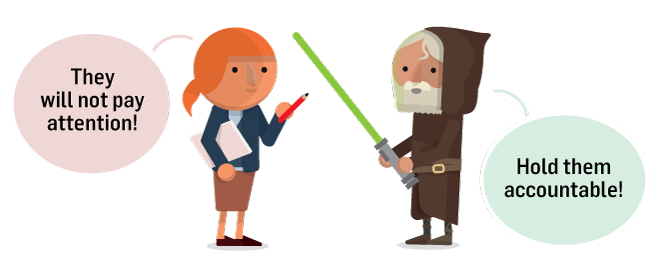
Solution – Hold them accountable
The design of the workshop can help capture and maintain the attention of the participants. Here, the key word is accountability. Ensuring that the participants know that their contributions is not only expected, it is in fact the whole point.
Involvement in itself fosters accountability. The participants should be actively engaged rather than passively listening for the vast majority of the session. As such, a virtual workshop should mostly focus on the participants talking with each other rather than you talking to them. Here, you can leverage the virtual format by organising participants in group discussions in breakout rooms (categorised by themes or tasks or whatever your imagination fancies).
You can even have the participants post videos with challenges and questions to each other on a shared site during or after the session. For instance, group A may do a presentation to which group B provides feedback, and group A then implements the feedback and presents in a plenary session in order to provide shared insight to guide the discussion going forward. In this way, participants are responsible for co-creating some of the content for the workshop as they go. The participants are now collaborators and the two groups are accountable to each other because they rely on the other group to solve a shared task.
As soon as you make participants engage with and comment on each other’s input you have created a feedback loop. And giving feedback is great for accountability. As noted, these feedback loops work best if the participants are accountable to each other rather than just to the person running the workshop. Shared accountability is a strong factor in involvement and a potent ingredient when creating workshops where the participants will want to participate fully and pay attention
Fear no.2 – We cannot communicate what we want
When we gather employees, it is first and foremost because we have something to say. We have a message that needs to be communicated before opening up the discussion and knowledge sharing. We may be presenting the new sales strategy, a model for team leadership to be tested or relevant findings from recent projects.
Whatever the message, it is certainly possible to do digital one-way communication. And one-way communication is often the go-to style for delivering corporate messages. The problem, however, is that of engagement. Any message, and even the greatest keynote, quickly becomes sterile in a virtual setting because the speaker is less able to interact with and feed of the energy of the audience. Long and jam-packed presentations become tedious, and with that we are challenging the participants’ ability to remember those crucial points that we essentially want them to consider. As a result, we cannot say as much as we would ideally like to.
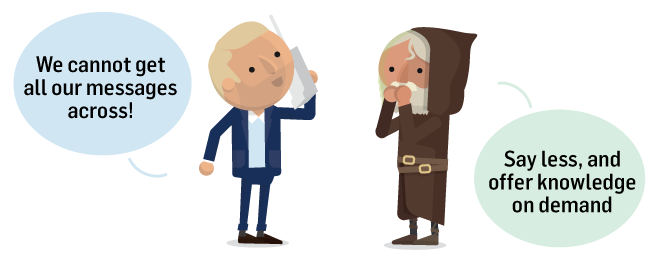
Solution – Say less, and offer knowledge on demand
The simplest, and most straight-forward, solution is to say less. To impose a vow of silence, focus on what is crucial and ban speeches longer than ten minutes. It works. Less is indeed more. That is not to say the need for one-way communication disappears. There are still things we need to tell the participants before they are able to engage in a meaningful dialogue.
One possible solution is to break out of the classic format of a full day non-stop session and instead, provide information in smaller chunks. Shorter sessions automatically call for less talking on the part of the host.
Since we do not have to gather people at the same location, a virtual workshop can be divided into shorter and more focused bursts which will also help keep engagement high. This can even be combined with assignments to be solved outside the workshop. In that case participants can gather for reflections and feedback later that day or even later that week. Consider this an extended version of the feedback loop described in fear no. 1.
When breaking down the well-known format you can also make information available on demand before the virtual session. For instance, the new compliance guidelines can be presented in a video by the company’s COO, and the participants can access this video when their schedule allows ‘homework’. Models, numbers and cases can be made available as a pre-read. Preferably alongside a number of reflection questions for the participants to ponder, so that they are ready to engage in discussion, when the virtual session starts.
Making content available on demand before, between and after the virtual sessions provides the participants with some flexibility and gives them the experience of a user-friendly and personal learning journey. It becomes a more dynamic way of packaging your message. In this way you need not say less, you just say less at the time.
Fear no. 3 – Our world is too complex for virtual discussions
Physical settings are great for complex discussions with a lot of moving parts. You go into a room with top level management, a white board and a lot of post-its. After eight hours you emerge with the outline for an organizational change towards more sustainable business practices. Throughout the eight hours the discussion has ranged far and wide from your current portfolio, over regulatory demands to customer wants and expectations as the participants think associatively and get new ideas.
Now, we are not saying that valuable discussions necessarily happen by putting people in the same room. But a lot of the depth and exploration in a discussion often comes when time and space allow participants to challenge the structure of it.
Unfortunately, challenging the structure does not go down well in a virtual setting. It would undoubtedly cause utter chaos. First of all, the lack of physical presence can make the discussion harder to follow and participants tend to decouple from a discussion if they become ‘messy’ and drift off topic. Second of all, the structure of virtual meetings is more rigid (due to e.g. participants’ attention span as described earlier) and hence harder to break.
This means that many online workshops only scratch the surface. They typically don’t succeed in accelerating those desired complex and explorative conversations.
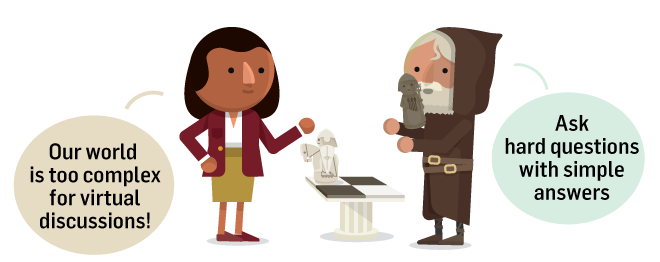
Solution – Ask hard questions with simple answers
Online discussions need not be shallow or easy. When they are, it’s due to a lack of consideration about how to foster the right kind of dialogues. Applying the right design choices can make an online discussion as deep and nuanced as its physical counterpart.
Structure is an absolute must. That’s why you should make it very clear what you won’t be talking about, what you will be talking about, and when. In our experience, if this is clear participants can concentrate on engaging with the specific matter at hand. We need this type of focus for the conversation to stay on track and thoroughly explore one avenue at the time.
If you also wish to mimic the free-flowing association game that happens more organically face to face, make it a point to communicate that this is your intention, and make this step of your session a separate bullet on your agenda. We recommend the use of visualisations such as progress bars to keep the participants informed about where they are in the process and what will be coming up later.
Another way to create depth in virtual discussions is by using breakout rooms. Doing so will ensure that there are not too many voices in the discussion drowning each other out and diluting the conversation and the findings. More groups made up of fewer participants will have a better chance at getting to the bottom of things and the level of complexity in the conversation increases much faster.
These types of focused discussions will also yield clearer answers which are easier to communicate. This is especially important if the purpose of the discussion is to feed something back into the rest of the organisation. Groups returning to plenary from a breakout session on the sustainability effort might present a ranking of the five most important initiatives for implementation rather than the full range of their discussion. This is what we mean by simple answers.
Even if the discussion itself has been deep and the outcomes hard to reach, it is important that the answer is simple and easy to communicate. You could facilitate this by asking participant to rank top 5 or bottom 5 ideas, list does and don’ts, or fill in the stop-start-continue model. Whatever you choose, you must harvest the depth of the conversations and document the results to make sure this is more than just table talk. In this way, valuable insights can be shared and potentially build upon later. There is nothing simple about finding them, the simplicity comes is how they are presented.
Fear no. 4 – It is impossible to connect on a personal level
In our experience networking and relationships is a prime motivation for many organisations when bringing people together, and a big appeal for many who choose to attend. Being in the same room fosters warmth and connection which in turn creates trust between people. And trust is often the secret ingredient to overcome the friction of a large and complex organisation.
Read more about the role of trust in complex organisations here.
But virtual settings are often cold and impersonal. We log on, we go through the agenda and we log off again not feeling any closer than when we started. There is no spontaneous connection over lunch. No informal chat in the coffee breaks. Attending a virtual workshop or summit with colleagues from around the world can ironically leave you feeling disconnected and alone with no sense of a shared experience or increased trust.
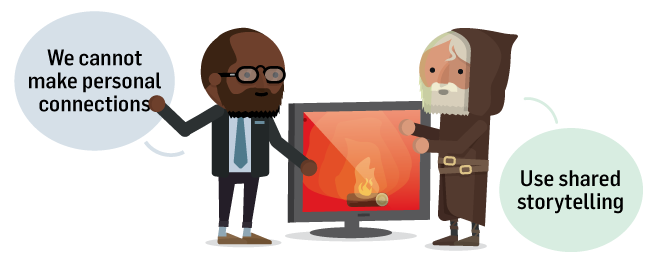
Solution – Use shared storytelling
It is possible to create warmth and connection in a digital setting, but unlike many physical settings where it happens organically as a by-product of sitting next to each other, virtual warmth needs to be designed for. In other words, connections have to be on the agenda.
Connections are often best cultivated one-on-one. It is much easier to build rapport with one other person in a virtual setting than with a larger group. This connection can be made by pairing up participants as learning buddies and have them work together throughout the sessions. They can also return to their learning buddy for reflection after working together in larger groups. However, learning buddies must get to know each other before they start working together. Especially if the workshop is on topics such as leadership development where honesty about strengths and weaknesses is crucial. You need to establish a certain level of trust before the participants are ready to be vulnerable.
At Workz, we use a simple interview exercise called “The Story of Me, The Story of Us, The Story of Now” adapted from Marshall Ganz’ concept of public narrative. In this exercise the participants choose a handful of questions to ask each other from a number of different categories moving from a personal to an organisational level, such as:
What is the most important thing your parents have taught you? What makes your current workplace and colleagues unique? What is your biggest dream on behalf of your organisation?
The questions are designed to link personal narratives with the purpose of the organization and with larger societal changes. The exercise acts as an alibi for vulnerability, and it will help create a deep connection between people in a short amount of time making them able connect with surprising ease – even while being miles apart.
Fear no. 5 – We will not get the alignment we need
Most workshops are part of a bigger picture. We want the participants to walk away and do something. Whether it is to start implementing the new sales strategy, experiment with being a more assertive team leader or increase focus on compliance. Usually, what we want to gain from a meeting or workshop is tied to a larger strategic purpose and ideally, the participants should leave more ready to act than when they arrived.
But it can be difficult to know whether a workshop has created the alignment we want. Have the participants taken the points away from the discussions that we intended? And will they implement them in real life, or will they be overwhelmed by the grind of daily operations?
This is a challenge for all types of involvement, but it is amplified in a virtual setting, because we often lack the little informal cues that communicate agreement and alignment. And because of the ease of logging off after a session, a virtual workshop does not necessarily have a handshake moment where everybody agrees on what and when to execute.
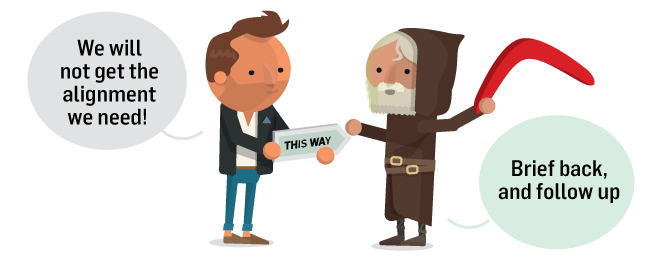
Solution – Brief back and follow up
One of our most treasured methods at Workz is the back brief. It’s origin dates back to 18th century Prussian military strategy and is still a valuable tool for ensuring alignment and empowerment in complex organizations.
A back brief is a way for the participants (soldiers at the time) to repeat their own understanding of the Why and the What of a given discussion. The intent is to make sure everyone is on the same page. In essence, rather than you just handing over a strategy to your participants they will rephrase it in their own words and explain what the overall intend of the strategy is and why it is necessary. In addition, they supply their own How by elaborating on what they will do personally to implement the strategy (and perhaps also in which areas they will need support and resources for this implementation). Through the back brief the participants break down their learnings from the workshop and they are urged to start transforming them into actionable tasks and responsibilities.
The back brief can act as a final handshake between the facilitator and the participants and between the participants themselves. This will help align their understanding of what direction the organization, or team, should be moving, and how.
Read more about using back brief as a method.
No matter how great a workshop you have put together, most participants will need follow-up activities to stay on track and to talk about, and perhaps change, what they have been trying to implement since the workshop. Follow-up is a crucial part of the setup because without it learnings are not anchored, and commitments are not seen through.
Back briefs are also a great tool for following up. You might want to follow up on the How and perhaps adjust deliverables after a period of experimentation or in the case of a strategy roll-out; a workshop participant can go back home and run a similar back brief session with their own employees. By doing this they can cascade the implementation by involving more people in reiterating the why and the what while supplying their own local how.
Virtual workshops have a tremendous benefit in not having to gather everybody together for follow-up. They can just log on and start the session.
Conscious choices = More valuable involvement
Involvement has a host of advantages: greater buy-in, the opportunity to generate more and better ideas and a better overall understanding of what is happening in the organisation. These advantages still hold true as we move towards a world where digital interaction is becoming commonplace. The only difference is, as we have less face-to-face contact and feel further apart, involvement becomes even more crucial. For this reason, we should be mindful that as the media through which we involve our employees change so does the activities, assignments and discussions. We cannot run an online workshop based on the design for a physical setting and expect the same results.
No matter if we find ourselves in the digital or analogue realm, involvement boils down to asking the right questions about our desired outcomes. Conscious design choices based on the desired answers is the only way to consistently create value through involvement.